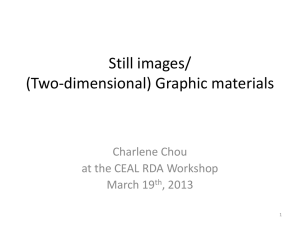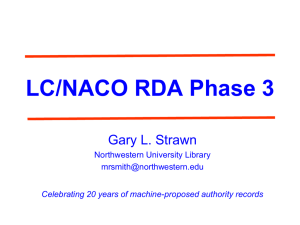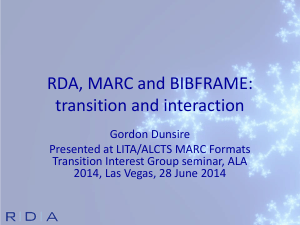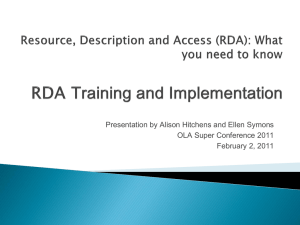PPT - Joint Steering Committee for Development of RDA
advertisement
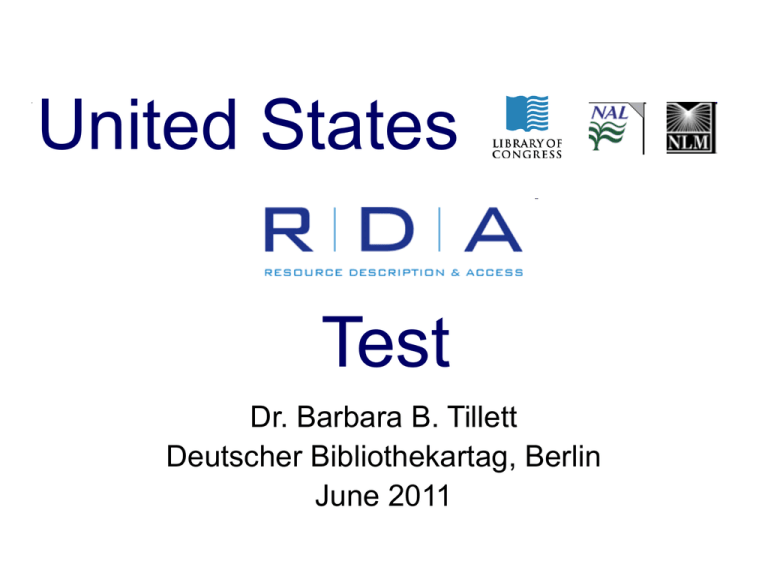
United States Test Dr. Barbara B. Tillett Deutscher Bibliothekartag, Berlin June 2011 What’s wrong with AACR? • Increasingly complex • Lack of logical structure • Mixing content and carrier data • Hierarchical relationships missing • Anglo-American centric viewpoint • Written before FRBR • Not enough support for collocation • Before Internet and well-formed metadata Based on slide from Ann Chapman, UKOLN 1997 International Conference on the Principles and Future Development of AACR • Principles • Toronto, Canada • JSC invited worldwide experts • Issues leading to RDA • Content vs. carrier • Logical structure of AACR • Seriality • Internationalization 3 Supporting Organizational Structure Committee of Principals AACR Fund Trustees/ Publishers ALA CC:DA Joint Steering Committee ACOC BL CCC CILIP/BL LC JSC and Project Management Team 2009 Marjorie Bloss, RDA project manager; Marg Stewart, CCC/ JSC chair; Alan Danskin, BL; John Attig, ALA; Barbara Tillett, LC; Deirdre Kiorgaard, ACOC; Hugh Taylor, CILIP; Nathalie Schulz, JSC secretary; Tom Delsey, editor 49 GOALS: RDA will be … • A new standard for resource description and access • Designed for the digital world • Optimized for use as an online product • Description and access of all resources • All types of content and media • Resulting records usable in the digital environment (Internet, Web OPACs, etc.) 6 RDA – The Goals • Rules should be easy to use and interpret • Be applicable to an online, networked environment • Provide effective bibliographic control for all types of media • Encourage use beyond the library community • Be compatible with other similar standards • Have a logical structure based on internationally agreed principles • Separate content and carrier data • Examples – more of them, more appropriate slide Ann Chapman, UKOLN AACR3 JSC Collaborations with Other Metadata Communities • IFLA - Principles, Conceptual models, ISBD/ISSN • ONIX (Publishers) – types of content, media, carriers • Dublin Core, IEEE/LOM, Semantic Web, W3C “Data Modeling Meeting” - London 2007 • RDA/MARC Working Group (MARBI) Other Collaborations • Law Library community – Treaties • Hebraica and Religion Teams at LC – Bible proposals • Mss/Archives experts at LC (Mss. Div., NUCMC, American Folklife Center, Rare Books) – DACS • Music Div. and Motion Picture, Broadcasting and Recorded Sound Div., Music Library Association – AMIM2 and RDA Ch.6 proposals for music • Prints & Photographs Division – CCO • Geography and Maps Divisions at LC Implementation of RDA • 2007 announcement of coordinated implementation: BL, LAC, NAL, LC Library and Archives Canada 12 US RDA Test - Background • 2008 Report of LC Working Group on the Future of Bibliographic Control – Cease work on RDA • LC worked with National Agricultural Library (NAL) and National Library of Medicine (NLM) to plan for U.S. test • U.S. RDA Test Coordinating Committee created 13 Purposes of the US RDA Test • To determine benefits versus costs • To see if initial release achieved the JSC objectives – Already knew JSC has list of issues to address after the first release • To determine whether the three US national libraries will implement the initial release of RDA – Yes, no, or with conditions Assumptions of the Test • • • • Results to be shared Test in current systems All data from the test freely available Testers provide experiences with – codes they currently apply – RDA Toolkit What? Criteria for Evaluation • High level operational criteria – How easy is RDA for catalogers to use? – Can RDA records be used in existing systems? – Can users find what they seek from RDA records? – Can libraries use RDA for access to a broader range of materials? 16 Criteria for Evaluation (continued) • Technical feasibility criteria— – Are RDA records interoperable with current records? – What changes are needed to MARC 21 (or future format schema)? – How easy is RDA Toolkit to integrate with other tools? 17 Criteria for Evaluation (continued) • Financial feasibility criteria— Determining costs of: – training – altered workflows – shifting from paper to subscription service for cataloging tool and documentation – conversion of existing data, if necessary 18 US Test of RDA http://www.loc.gov/bibliographic-future/rda/ Who? Test partners • 26 formal test partners, including LC, NAL, NLM • Partners included a cross-section: – Types, sizes, formats, content, content codes used – Libraries, consortia, educators, vendors – Program for Cooperative Cataloging libraries – OCLC 20 When? U.S. RDA Test Timeline • June 2010 ALA released RDA Toolkit • June-Aug.31 ALA allowed free access to RDA Toolkit to everyone who registered • June-Sept. 30 U.S. testers were training and had time to practice • Oct. 1-Dec. 31 U.S. test of RDA • Jan.-May 2011 analysis of test results 21 Announcing U.S. National Libraries’ Decision • Early June: Decision made • Mid-June: Decision announced • Third week of June: Program for Cooperative Cataloging statement issued • June 23-28: Discussions/presentations on decision during American Library Association Annual (ALA) Conference 22 The Test - Methodology • Common Original Set (25 titles) – AACR2 (or other current rules) – RDA • Common Copy Set (5 titles) • Extra Original Set • Extra Copy Set • Surveys Feedback from Participants • Surveys for cataloger’s experience and costs • Feedback on user reaction to records built on RDA instructions – To help inform future adjustments to RDA – To help improve the IFLA models and principles • Test records http://www.loc.gov/catdir/cpso/RDAtest/rdatestrecords.html 24 Summary of RDA Records Collected Bibliographic Common original set Common copy set Extra set 1,514 1,226 122 Informal testers Totals Authority 10,570 8,548 11,457 386 117 12,800 25 LC’s internal activities • Prepared training materials • Prepared documentation • Posted training materials & documentation to U.S. Test Site and LC Cataloging Policy Site • Training/practice for participating LC staff – 50 staff were involved 26 Contents of Final Report • Recommendations & impact for – LC/NAL/NLM senior management – U.S. library community (including PCC) – Joint Steering Committee – Vendors (including OCLC) – Co-publishers 27 Contents of Final Report (continued) • Evaluation methodology • Findings • Appendices – Data collected – Lessons learned – Webliography 28 RDA Benefits • Creates framework to bring library metadata into current information technology for Web use – Element-based descriptions: easier re-use of wellformed metadata, element sets, RDA Registry – More re-use of pre-existing metadata – Encourages development of new schema, new resource discovery systems • More user- centered (FRBR/FRAD user tasks) – – – – – Information not abbreviated, not Latin More relationships indicated Potentially more access points (rule of 3 optional) More distinguishing data in authority records Potential for increased international sharing Contact/more information • RDA content and LC Policy Statements (LCPSs) – Email: LChelp4rda@loc.gov • MARC 21 standards – http://www.loc.gov/marc/ • Joint Steering Committee for Development of RDA – http://www.rda-jsc.org/ • RDA Toolkit assistance – www.rdatoolkit.org 30 LC Webcasts (free) • Resource Description and Access: Background/Overview (May 14, 2008. 67 minutes) http://www.loc.gov/today/cyberlc/feature_wdesc.php?rec=4320 • Cataloging Principles and RDA: Resource Description and Access. (June 10, 2008. 49 minutes) http://www.loc.gov/today/cyberlc/feature_wdesc.php?rec=4327 • FRBR: Things You Should Know but Were Afraid to Ask. (March 4, 2009. 57 minutes) http://www.loc.gov/today/cyberlc/feature_wdesc.php?rec=4554 • RDA: Looking to the Future: Information Systems and Metadata. (March 9, 2010. 54 minutes) http://www.loc.gov/today/cyberlc/feature_wdesc.php?rec=4967 31

